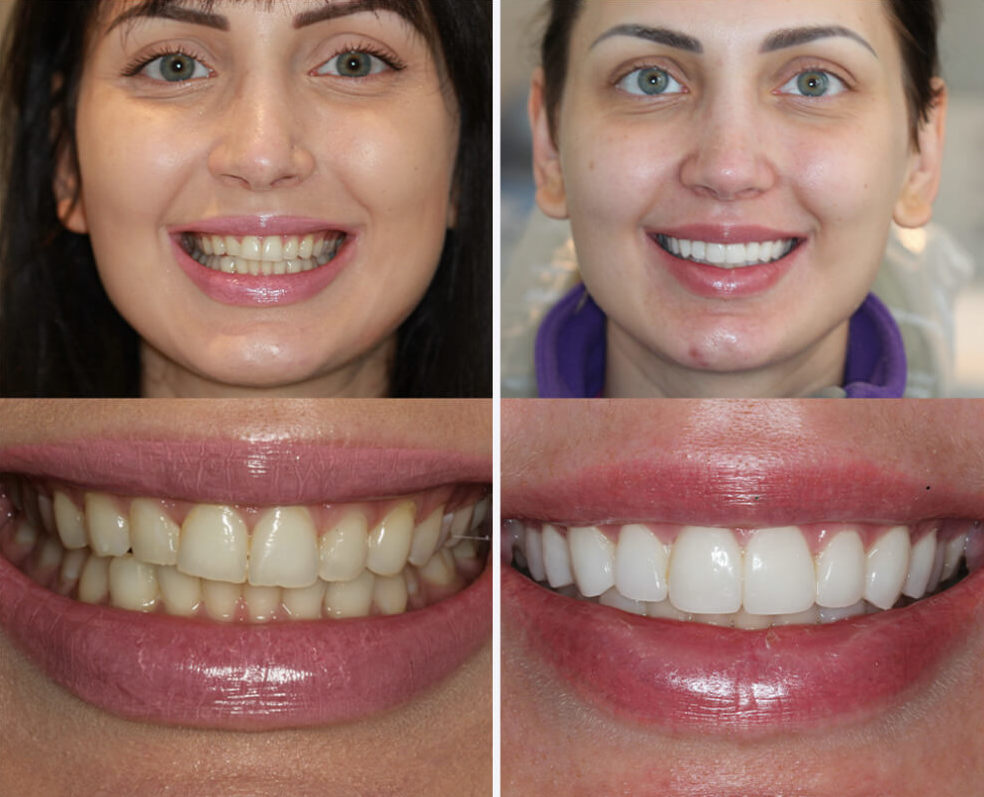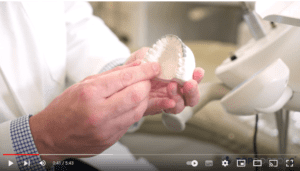What Are Veneers?
They are basically like false fingernails that fit over the front and the edge of the teeth. They are designed basically to enhance and improve the colour of the teeth, the size of the teeth and the shape of the teeth and they are one of the most commonly used cosmetic dentistry materials.
Veneers are basically made of two materials. One is porcelain and the other is composite resin, and the veneer basically is designed to fit over the front of the teeth and just slightly over the edge, as you can be seen in our explainer video.
Porcelain Veneers
Porcelain is a glass-like substance, also sometimes called ceramic. Veneers are the most life-like, most durable and prettiest form of veneer and they generally have to be made in the dental laboratory by one of our master ceramic technicians.

Resin Veneers
The other method is to use a composite resin and again they can also be made in the laboratory. But very often they’re done by the dentist’s chair side, and the dentist uses his/her artistry and his skill to build the veneer up directly onto the patient’s tooth.
Composite Bonding or Ceramic Technicians
If veneers are made with a very skilled pair of hands, either the dentist’s hands, for example, making composite veneers often called bonding or the master ceramic technicians that make porcelain veneers in essence, the skill of the craftsman. Making those two things is the most important factor in having them look natural.
The second most important factor is the desire of the patient. Some of our patients want very natural, very aesthetic results so the enhancement of their teeth, but not necessarily to make them look fake. And that aesthetic choice is a personal choice. Some patients come and want the Hollywood smile or the most perfect set of white teeth, and they can look less natural and more cosmetic. But again, that is down to the choice of the patient and the desire for what they want to look like. A lot of the final result comes down to the skill of the craftsman that makes the veneers, alongside the skill and experience of the Dentist in instructing that craftsman.
Veneers and caps are generally not referring to the same thing. The traditional term ‘cap’ is usually referring to a crown. In the dental profession, the terminology is something that completely envelopes the whole tooth. It’s 360 degrees, wraps the complete tooth. A cap is very often done when the tooth has completely broken down and needs major reconstruction. Whereas a veneer, as the term suggests, is a very thin layer that fits just over the front of the tooth, almost like a false fingernail, and overlaps the edge of the tooth. So, in essence, the bulk of the tooth structure is still intact, and veneer sometimes requires very, very little and in some cases, no tooth reduction or tooth preparation. But in most cases, a very minimal tooth reduction, whereas a cap very often requires a lot of tooth structures to be removed.
How Much do Veneers Cost?
The cost of veneers depends on a lot of factors. There are quite a few variables. There are two main types of veneers. Those that are made of porcelain and they’re made in a dental laboratory with a dental technician and then there are veneers that are made chair side, using composite resin, often done purely by the dentist directly on the tooth, so laboratory-made veneers will carry an extra cost because of the fee that the dental technician will charge. Whereas composite resin veneers often do not carry that fee and are usually about 50% of the cost of the porcelain veneers, the composite veneers can also be done in one visit, usually, so you are not paying for as much of the dentist’s time. The cost will also depend very much on quality. That might be the quality of the craftsmanship.
So, that could be the dentist, their skill and their experience in doing that particular treatment, or the craftsmanship and quality of the dental technician or the ceramist who makes the porcelain veneers. And as in all professions, there are very highly skilled masters in those fields and those that are less experienced. The complexity or the difficulty of the case for that patient will also have a bearing on the cost. And, often the number of veneers done per procedure will have some bearing on costs. For example, if you’re having multiple teeth veneered, the individual cost of the veneer could come down.
Whereas a single tooth that has to be matched perfectly to a natural tooth next to it can be almost as costly as having two teeth done because of the difficulty of doing that procedure. It really varies, and it will vary from person to person as a ballpark in southern England. In London, a composite veneer will cost anywhere from £300 to £500 currently, and you may pay anywhere from £700 to £1500 per tooth for a porcelain veneer.
For all of the latest updates, make sure to stay connected on socials:
Book your virtual consultation here.


